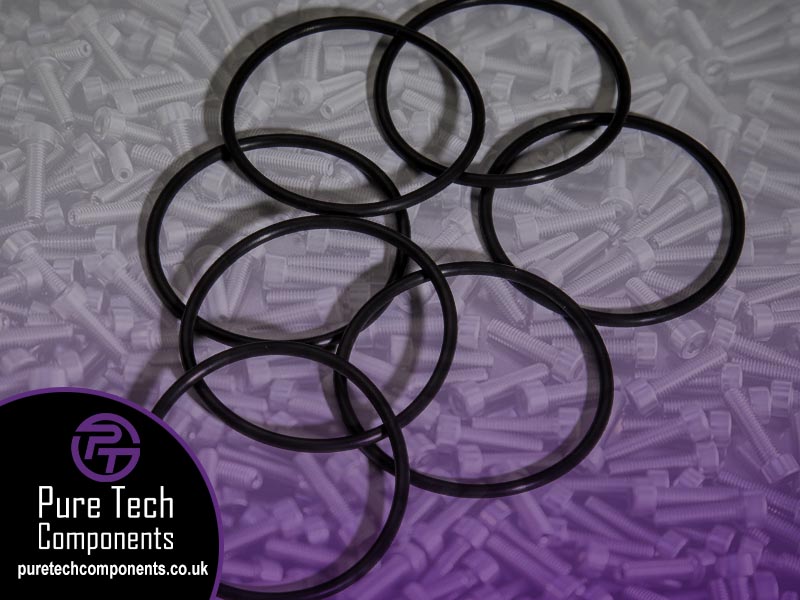
O-rings are most often the primary source of contamination in any vacuum system. Selecting the proper O-ring design and material is essential to maintaining the seal and overall system integrity. Unfortunately, you cannot simply rely on the property values you get for the elastomers when selecting an O-ring for your clean-critical application; the vacuum performance of the material can differ strongly from supplier to supplier, as well as batch to batch.
Why is the material so important?
The key factors to look at in material selection for your O-rings include:
- Permeability
- Surface contamination
- Outgassing from the compound
- Chemical compatibility
Permeability
All elastomers have some permeability to gases. Each polymer has a different permeation rate to different gasses which is also affected by the temperature of the environment. Permeability, or permeation, of gasses through an O-ring differs greatly based on the material, hardness, temperature, thickness of the O-ring, overall size of the O-ring, pressure, lubrication, and type of gas. The most common O-ring material for vacuum applications is FKM Viton® A or a similar fluoroelastomer. Please note that not all of the O-ring materials listed below are necessarily suitable for vacuum service.
Permeation (10-8 sccm, cm/sec, cm2, atm):
| MATERIAL | HE | H2 | H2O | N2 | CO2 |
| Buna-N | 8 | 2.5 | 760 | 0.1 | 25 |
| EPDM | 25-30 | 16-18 | – | 6-7 | 85 |
| Fluorosilicone | 140 | 80 | – | 40 | 400 |
| FKM Viton® A | 9-22 | 1-2 | 40 | 0.05-0.7 | 5 |
| FKM Viton® GF | 30 | 3 | – | 2 | – |
| KEL-F | – | 0.1 | 0.1 | 0.5 | |
| Markez® FFKM | 60-80 | 6-8 | 90-100 | 8-12 | – |
| PTFE | – | 0.4 | – | 0.14 | 0.12 |
| Polyimide | 1.9 | 0.1 | – | 0.3 | 0.2 |
| Silicone | 250 | 75-450 | 8,000 | 200 | 2,000 |
Surface Contamination
During the manufacturing process, a number of factors can affect the surface quality of the finished O-ring produced including factory temperature and humidity, the age and finish of the O-ring molds, mold lubricants and/or mold release powder, curing, flashing or residual seam presence, storage, handling, and packaging. Each of these factors can contribute to what is typically a very dirty O-ring.
The RediVac® process addresses raw O-ring quality via individual inspection, executes a process for surface contamination removal, and can take it to the next level with vacuum bake-out to remove water vapor and some volatile organics. This process concludes with proper handling and packaging and can be accompanied by additional processing documentation upon request.
Outgassing
An unprocessed, or “raw”, O-ring will contain a great deal of water which is chemically formed during the manufacturing process. Additional solvents and plasticizers with low vapor pressures will also likely be present. These contaminants will gradually come to the surface, desorb (outgass), and be pumped away as a gas. The higher the load the longer this will take and the potential for process contamination will grow. Outgassing is a common problem when creating, or maintaining, a clean high-vacuum environment. High-vacuum environments, as well as high temperatures, increase the rate of outgassing due to vapor pressure and an increase in chemical reactions.
Proper processing is key to turning a basic, widely available, generally inexpensive raw O-ring into a tool that can safely be deployed in a vacuum process. One of the best ways to help reduce outgassing is the use of specifically formulated and treated O-ring installation – cleaned or vacuum-baked O-rings. We are proud to supply UC Components’ RediVac® O-rings which undergo this critical processing.
How can we help you?
RediVac® O-rings address the problem with supplier-to-supplier and batch-to-batch differentiation. All UC manufacturing process steps that affect the form, fit, function, or appearance of a component are fixed to ensure that our customers always receive the best and most consistent possible performance from all of these products.
We offer two types of RediVac® O-rings: Cleaned and Vacuum-Baked.
Cleaned O-Rings undergo a proprietary cleaning process, designed to reduce or eliminate surface particulate contamination originating from injection-mold release agents and post-mold handling. All cleaning and packaging is performed in a certified Class 100/ISO Class 5 Cleanroom. This process is based on typical requirements for pre-cleaning elastomer seals prior to installation for vacuum service.
Vacuum Baked O-Rings also go through the precision cleaning process. This is followed by an extended vacuum bake-out process designed to remove trapped water within the O-ring polymer. Vacuum baking reduces water vapor outgassing under vacuum by orders of magnitude. The primary gas load in most vacuum systems is water. These vacuum baked O-rings are packaged in a Class 100/ISO Class 5 Cleanroom, nitrogen backfilled, and double bagged.
Pure Tech Components is the premier UK distributor for UC Components, Inc. RediVac® line of fasteners, washers, hex nuts, and O-rings. We provide only the best specialised fasteners to a wide range of industries, including medical, food processing, optical, vacuum, semiconductor, and R&D. Partnering with us gives you the confidence and reassurance you need to concentrate on your customer’s needs without worrying or compromising on cost, quality, or customer service. Contact us today for more information or to place an order.
